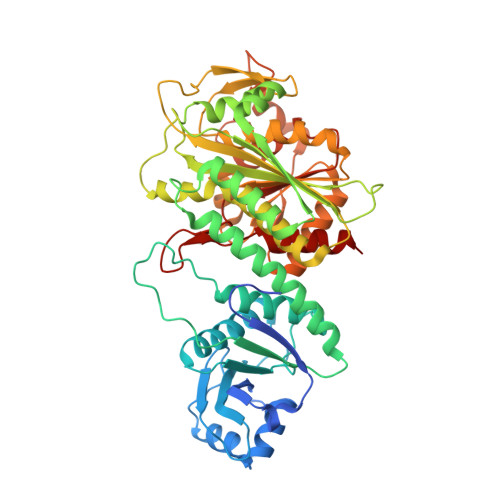Unveiling the Catalytic Mechanism of a Processive Metalloaminopeptidase.
Simpson, M.C., Harding, C.J., Czekster, R.M., Remmel, L., Bode, B.E., Czekster, C.M.(2023) Biochemistry 62: 3188-3205
- PubMed: 37924287
- DOI: https://doi.org/10.1021/acs.biochem.3c00420
- Primary Citation of Related Structures:
8PZ0, 8PZM, 8PZY - PubMed Abstract:
Intracellular leucine aminopeptidases (PepA) are metalloproteases from the family M17. These enzymes catalyze peptide bond cleavage, removing N-terminal residues from peptide and protein substrates, with consequences for protein homeostasis and quality control. While general mechanistic studies using model substrates have been conducted on PepA enzymes from various organisms, specific information about their substrate preferences and promiscuity, choice of metal, activation mechanisms, and the steps that limit steady-state turnover remain unexplored. Here, we dissected the catalytic and chemical mechanisms of Pa PepA: a leucine aminopeptidase from Pseudomonas aeruginosa . Cleavage assays using peptides and small-molecule substrate mimics allowed us to propose a mechanism for catalysis. Steady-state and pre-steady-state kinetics, pH rate profiles, solvent kinetic isotope effects, and biophysical techniques were used to evaluate metal binding and activation. This revealed that metal binding to a tight affinity site is insufficient for enzyme activity; binding to a weaker affinity site is essential for catalysis. Progress curves for peptide hydrolysis and crystal structures of free and inhibitor-bound Pa PepA revealed that Pa PepA cleaves peptide substrates in a processive manner. We propose three distinct modes for activity regulation: tight packing of Pa PepA in a hexameric assembly controls substrate length and reaction processivity; the product leucine acts as an inhibitor, and the high concentration of metal ions required for activation limits catalytic turnover. Our work uncovers catalysis by a metalloaminopeptidase, revealing the intricacies of metal activation and substrate selection. This will pave the way for a deeper understanding of metalloenzymes and processive peptidases/proteases.
Organizational Affiliation:
School of Biology, University of St Andrews, North Haugh, Biomolecular Sciences Building, KY16 9ST, Saint Andrews, United Kingdom.


















